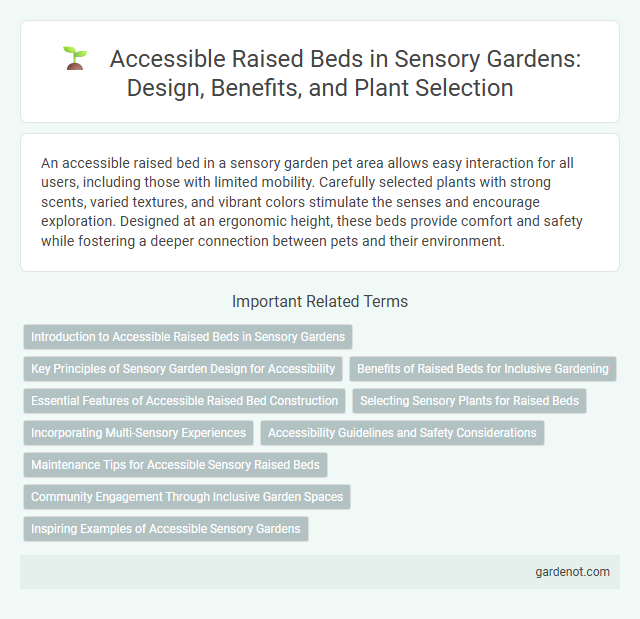An accessible raised bed in a sensory garden pet area allows easy interaction for all users, including those with limited mobility. Carefully selected plants with strong scents, varied textures, and vibrant colors stimulate the senses and encourage exploration. Designed at an ergonomic height, these beds provide comfort and safety while fostering a deeper connection between pets and their environment.
Introduction to Accessible Raised Beds in Sensory Gardens
Accessible raised beds in sensory gardens offer an inclusive gardening experience designed to accommodate individuals with limited mobility or physical disabilities. These beds are typically elevated to wheelchair-accessible heights, allowing easy reach and engagement with various sensory plants like aromatic herbs, textured foliage, and vibrant flowers. Incorporating accessible raised beds enhances interaction, promotes therapeutic benefits, and supports sensory stimulation for diverse visitors.
Key Principles of Sensory Garden Design for Accessibility
Accessible raised beds in sensory garden design prioritize ergonomic height, ensuring wheelchair users can engage comfortably without strain. Incorporating diverse textures and aromatic plants within easy reach stimulates multiple senses while promoting inclusivity. Effective drainage and safe, sturdy materials enhance usability and maintenance, aligning with universal design principles.
Benefits of Raised Beds for Inclusive Gardening
Accessible raised beds enhance inclusive gardening by providing ergonomic heights that reduce strain for individuals with mobility challenges, facilitating easier planting and harvesting. These beds improve soil quality control and drainage, creating optimal growing conditions that boost plant health and yield. By promoting independence and encouraging sensory engagement, raised beds support therapeutic and educational experiences for gardeners of all abilities.
Essential Features of Accessible Raised Bed Construction
Accessible raised beds feature adjustable heights between 24 to 36 inches to accommodate wheelchair users and individuals with limited mobility, ensuring ergonomic comfort while gardening. Durable, non-toxic materials such as cedar or composite lumber provide structural stability and resistance to weathering, while smooth edges prevent injuries. Wide, obstacle-free pathways of at least 36 inches around the bed enable easy access, and integrated seating or tool holders enhance usability for people with diverse physical needs.
Selecting Sensory Plants for Raised Beds
Selecting sensory plants for accessible raised beds involves choosing species that engage multiple senses, such as fragrant lavender, tactile lamb's ear, and visually striking purple coneflowers. Raised beds should accommodate easy reach and maintenance, with plants that vary in texture, color, and scent to stimulate touch, sight, and smell effectively. Incorporating drought-tolerant and low-maintenance varieties like sedum and rosemary ensures year-round sensory interaction and accessibility for all users.
Incorporating Multi-Sensory Experiences
Accessible raised beds in sensory gardens enhance inclusivity by providing wheelchair-friendly height and easy reach for all users. Incorporating multi-sensory experiences involves selecting plants with varied textures, fragrant blooms, and vibrant colors, stimulating tactile, olfactory, and visual senses simultaneously. Features like herbs, textured foliage, and wind chimes can further enrich sensory engagement, creating an immersive and interactive garden environment.
Accessibility Guidelines and Safety Considerations
Accessible raised beds in sensory gardens adhere to Accessibility Guidelines such as the Americans with Disabilities Act (ADA) to ensure height and width accommodate wheelchair users and individuals with limited mobility. Safety considerations include using smooth, splinter-free materials, rounded edges, and stable construction to prevent accidents while promoting tactile engagement. Proper soil drainage and non-toxic plants further enhance a secure, inclusive garden experience.
Maintenance Tips for Accessible Sensory Raised Beds
Accessible raised beds in sensory gardens require regular maintenance to ensure plant health and ease of use for all visitors. Maintain soil fertility by adding organic compost biannually and monitor moisture levels with drip irrigation systems to prevent over- or under-watering. Keep pathways clear and bed edges smooth to enhance mobility for wheelchair users and incorporate seasonal pruning to encourage vibrant sensory stimulation.
Community Engagement Through Inclusive Garden Spaces
Accessible raised beds in sensory gardens foster community engagement by providing inclusive gardening spaces that accommodate individuals with diverse abilities. These thoughtfully designed structures enable easy access for wheelchair users and those with limited mobility, encouraging collaborative planting and sensory exploration. Inclusive garden spaces enhance social interaction, promote environmental stewardship, and strengthen community bonds through shared horticultural experiences.
Inspiring Examples of Accessible Sensory Gardens
Accessible raised beds in sensory gardens enhance engagement for individuals with limited mobility by providing easy-to-reach planting areas. Inspiring examples include the Eden Project's inclusive garden, featuring wheelchair-friendly raised beds at ideal heights for tactile exploration and planting. These designs promote inclusive horticulture, encouraging sensory stimulation through varied textures, scents, and colors within physical reach.
Accessible raised bed Infographic

 gardenot.com
gardenot.com